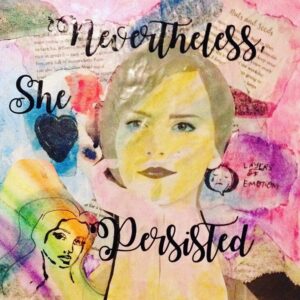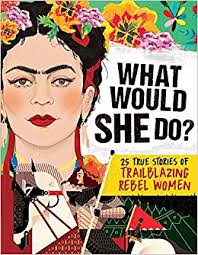MakerSpace: Mixed Media Collage and Recycling Books
For a variety of reasons, libraries are just as much in the business of getting rid of books as they are purchasing them. One, having shelf space for the new means we have to get rid of the old. Many books become outdated, inaccurate, overly worn, and no longer popular. So yes, we discard books. In the Teen MakerSpace, we have been looking at ways to re-use some of these discarded books to make art. I’ve also been exploring the concept of mixed media, which I talked about some a couple of weeks ago.
As the YA Services Coordinator at my library, I don’t just build collections but I have created our Teen MakerSpace and my job involves exploring, coordinating, and implementing new projects and stations to incorporate into the Teen MakerSpace to keep it fresh, interesting, and truly educational. Lately, because of the interests of our local teens, I have been looking at some more traditional art styles, including mixed media. Mixed media involves using a variety of techniques and tools to create a single piece of art. You can use basically anything, anything at all. For it to be truly mixed media, it has to by definition include more than one type of technique, tool or medium. The final product is often some type of collage. This is the example collage that I created (we have found that our teens like to have examples to help explain the project and inspire them).
ADVERTISEMENT
ADVERTISEMENT
Supplies:
- Book pages (here I used a couple of ARCs that I have received because you can’t resell them or add them to your collection)
- Watercolor crayons
- Watercolor paint
- Acrylic stamps
- Speedball screenprinting ink
- A brayer
- A Silhouette Cameo vinyl cutter
- Permanent vinyl
- Mod podge
- A blank canvas
The glory of mixed media is that you kind of can’t mess up. I mean, there were individual pieces that I messed up, but then I just cast them aside and tried again. I painted pages and let them dry. After they dried I stamped on them using the stamps and screen printing ink. I ripped pages up and glued them down onto my blank canvas. I mod podged the entire thing. And then after it dried I used my vinyl cutter to make my lettering and then mod podged it again. I can’t draw and I can’t even read my own handwriting, so using stamps and the vinyl cutter let me create the effect I was looking for in a way that was stylish and I could proudly hang on my wall.
The picture of Emma Watson was a black and white illustration from the book What Would She Do? 25 Trailblazing Rebel Women. I used watercolor crayons to give them color. The words themselves are from a couple of pages of other books. It is important when doing something like this that you discuss copyright with your teens. I obviously couldn’t sell this piece, but it’s hanging right now on The Teen’s bedroom wall to inspire and empower her. She’s graciously pretending that she loves it until I hang it in my Teen MakerSpace.
Taking it to the next level:
Because we are always exploring taking our projects to the next level in the Teen Makerspace, we never end with the creation of a piece of art. We then explore what else we can do with that art, and we like to involve technology if we can. So for every piece of paper art you create, keep in mind you can do multiple things with that art. For example, you can photograph your final piece of art and mix it with digital media tools to create a new piece. Use filters, add stickers and frames and overlays. Then you can take that new creation even further: print it out and make it into a button using a button maker or print them on card stock to make note cards or postcards. With mixed media collage such as the one I made above that include other people’s images you’ll want to be very careful about copyright issues, but on the whole if you create an original piece of art there are a lot of interesting ways you can use technology to enhance it, redefine it, recreate it and redistribute it. Some of our teens our using our TeenMakerSpace to build portfolios for college and create an online following. Teen MakerSpaces aren’t just about dabbling and learning, many of our teens are using the space in powerful ways to build a name and an audience for themselves. It’s not about starting their future, it’s about the here and now. It’s pretty amazing to witness.
And remember, making doesn’t always have to be about technology. If you make something, you are a maker.
Filed under: Makerspace
About Karen Jensen, MLS
Karen Jensen has been a Teen Services Librarian for almost 30 years. She created TLT in 2011 and is the co-editor of The Whole Library Handbook: Teen Services with Heather Booth (ALA Editions, 2014).
ADVERTISEMENT
ADVERTISEMENT
SLJ Blog Network
One Star Review, Guess Who? (#202)
This Q&A is Going Exactly As Planned: A Talk with Tao Nyeu About Her Latest Book
More Geronimo Stilton Graphic Novels Coming from Papercutz | News
Parsing Religion in Public Schools
ADVERTISEMENT











Thank you Karen for sharing your cool project and mentioning that traditional art and creative processes still belong in the Makerspace. I honestly have a hard time keeping pace with my local schools when it comes to providing the latest technology instruction, but I find my teens are still challenged by traditional creative projects. They love the hands-on “zen” of working with their hands and making things from paint, textiles, recycled materials and of course – their imaginations. The original Makerspace movement was all about providing space and materials and instruction so that people could try new things. This can range from 3-D printers to harvesting seeds and planting them in a butterfly garden. The key is promoting discovery – both of new processes and personal ability.